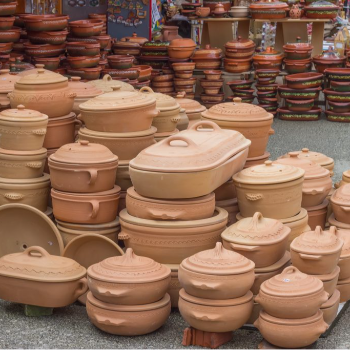In the bustling city of Pune, Anjali Deshmukh, a young homemaker, found herself at a crossroads. The daily grind of managing a household and the constant desire to ensure the well-being of her family weighed heavily on her. Anjali, like many modern Indian women, was caught between the convenience of fast-paced living and the yearning for a more traditional, sustainable lifestyle. Her kitchen was filled with non-stick cookware and stainless steel pots, silently contributing to environmental degradation and possibly affecting her family's health.
Anjali's story is one that resonates with countless Indian families. The dilemma of choosing between practicality and sustainability is a major challenge faced by today’s homemakers. The primary problem Anjali faced was finding a way to incorporate eco-friendly practices into her daily routine without sacrificing convenience or the quality of her family’s meals.
One day, while attending a local farmer's market, Anjali stumbled upon an artisan selling beautifully crafted clay utensils. The sight of these earthy, traditional vessels took her back to her grandmother’s kitchen, where the rich aroma of dal simmering in a clay pot was a staple memory. Intrigued, Anjali engaged the artisan in conversation and learned about the multitude of benefits these utensils offered. Not only were they environmentally friendly, but they also enhanced the flavor of the food and retained nutrients better than metal cookware.
The turning point for Anjali came when she decided to purchase a clay pot and try it out. Her first meal cooked in a clay pot was a simple vegetable curry. As the pot simmered on the stove, the aroma filled her kitchen, evoking nostalgia and a sense of connection to her roots. And the taste? It was unlike anything her family had experienced before—rich, earthy, and full of flavor.
The transition to clay utensils was not without its challenges. Anjali had to learn how to properly season and care for the clay pots, a practice her grandmother once mastered. However, as she embraced this new way of cooking, she noticed a significant improvement not only in the taste of her food but also in her family's health. The clay pot naturally balanced the acidity of the food and retained essential nutrients, something her non-stick pans failed to do.
Anjali's journey is a testament to the potential of clay utensils to solve a modern problem—bridging the gap between sustainable living and practicality. By choosing eco-friendly clay utensils, she was able to significantly reduce her household’s environmental footprint and promote a healthier lifestyle for her family. The clay utensils became more than just kitchenware; they were a symbol of tradition, sustainability, and the love she had for her family.
Clay utensils are not just a relic of the past; they are a viable solution for the future. They offer an opportunity to reconnect with our cultural heritage while addressing pressing environmental concerns. Anjali’s story serves as inspiration for countless others like her, who seek to make a positive change in their lives and the world around them.
Incorporating clay utensils into your kitchen is a simple yet powerful step towards sustainable living. As more families adopt this practice, the collective impact on the environment can be profound. So, the next time you find yourself in a dilemma like Anjali’s, remember her story and consider making the switch to clay. Your taste buds, your health, and the planet will thank you.
In conclusion, the choice to embrace clay utensils is more than just a nod to tradition; it is a commitment to a sustainable future. Let Anjali’s experience guide you towards a healthier, more environmentally friendly lifestyle, one clay pot at a time.
Visit Vyaparify Site:
https://id.vyaparify.com/seaclap-international 
